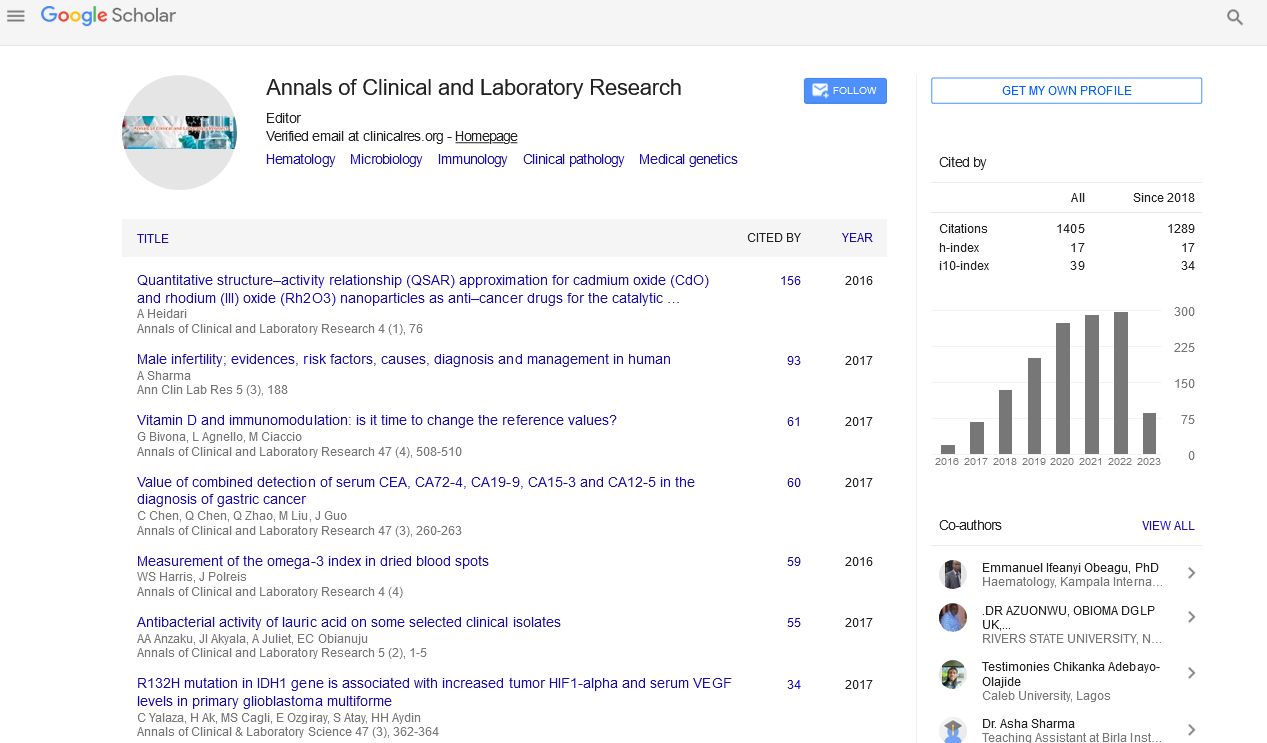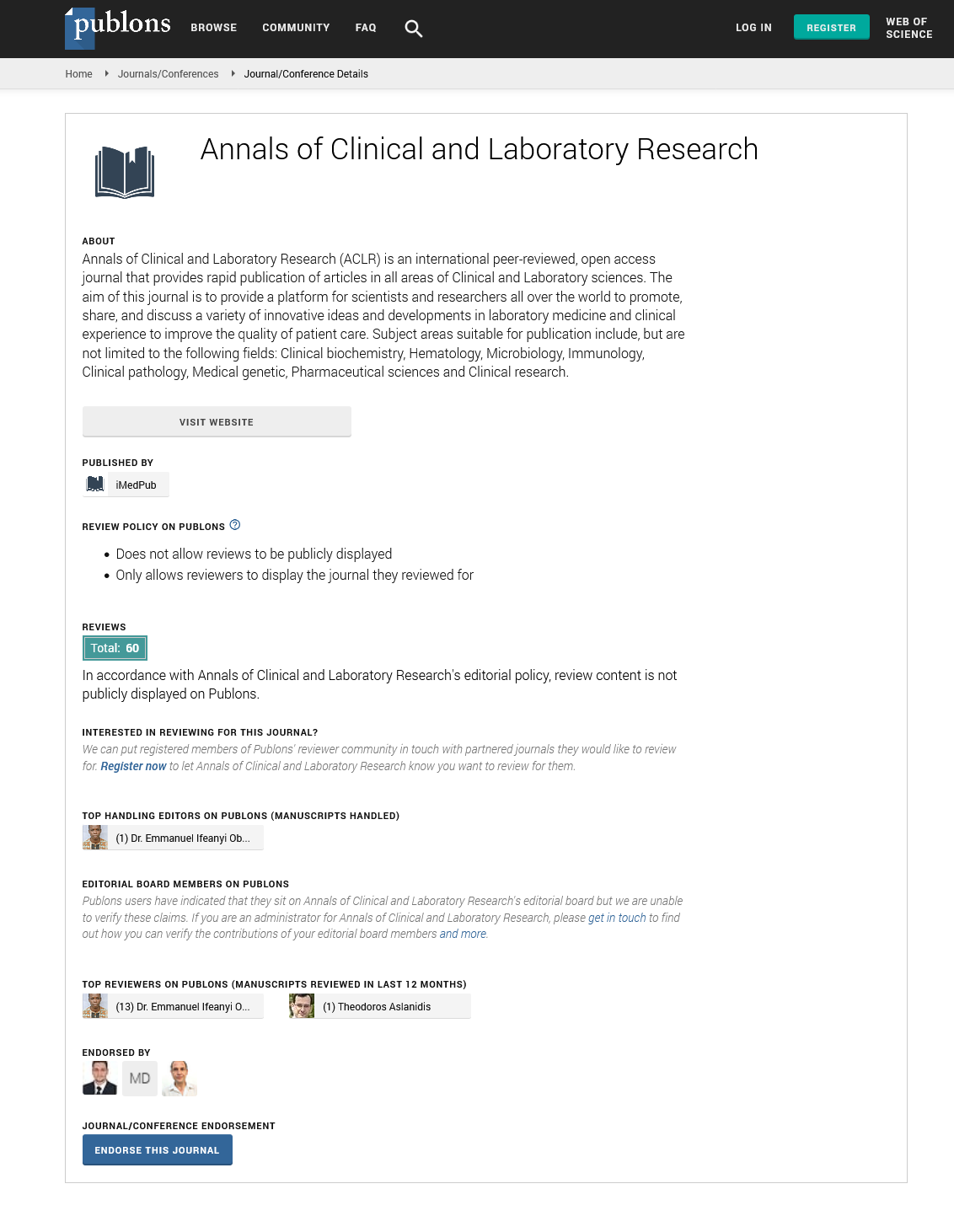Mini Review - (2023) Volume 11, Issue 2
Breaking Down Barriers: The Power of Enzyme Inhibitors in Treating Diseases and Disorders
Edward Flynn*
Department of Biophysics, Federal University of São Paulo, São Paulo, Brazil
*Correspondence:
Edward Flynn, Department of Biophysics, Federal University of São Paulo,
Brazil,
Email:
Received: 02-Feb-2023, Manuscript No. IPACLR-23-13625;
Editor assigned: 04-Feb-2023, Pre QC No. IPACLR-23-13625;
Reviewed: 18-Feb-2023, QC No. IPACLR-23-13625;
Revised: 21-Feb-2023, Manuscript No. IPACLR-23-13625;
Published:
25-Feb-2023, DOI: 10.36648/2386- 5180.23.11.456
Introduction
Enzymes are proteins that catalyse biochemical reactions in
living organisms. They play critical roles in various metabolic
pathways, and their activity must be tightly regulated to maintain
homeostasis. Enzyme inhibitors are molecules that can bind to
enzymes and interfere with their activity, thereby regulating the
rate of the biochemical reaction [1]. Types and mechanisms of
enzyme inhibitors, as well as their applications in medicine and
industry.
There are two main types of enzyme inhibitors: reversible and
irreversible. Reversible inhibitors can bind to and dissociate from
the enzyme, while irreversible inhibitors form a covalent bond
with the enzyme, permanently inactivating it.
Reversible inhibitors can be further classified into competitive,
non-competitive, and uncompetitive inhibitors. Competitive
inhibitors bind to the active site of the enzyme, preventing the
substrate from binding. Non-competitive inhibitors bind to a site
other than the active site, changing the enzyme's conformation
and reducing its activity. Uncompetitive inhibitors bind to the
enzyme-substrate complex, preventing the release of the product
and reducing the overall reaction rate [2].
Irreversible inhibitors, as the name suggests, form a covalent
bond with the enzyme, irreversibly inactivating it. They are often
used in the development of drugs, as they can provide longlasting
effects.
The mechanisms of enzyme inhibition can vary depending on
the type of inhibitor. Competitive inhibitors compete with the
substrate for binding to the active site of the enzyme, effectively
reducing the concentration of active enzyme available to catalyse
the reaction. Non-competitive inhibitors, on the other hand,
bind to a site other than the active site, altering the enzyme's
conformation and reducing its activity. Uncompetitive inhibitors
bind to the enzyme-substrate complex, preventing the release of
the product and reducing the overall reaction rate [3].
Reversible inhibition can be further divided into three types:
Competitive, Uncompetitive, and Non-competitive inhibition.
Competitive inhibition occurs when a molecule, known as
the inhibitor, competes with the substrate for the enzyme's
active site. The inhibitor molecule binds to the active site and prevents the substrate from binding, reducing the enzyme's
activity. Competitive inhibitors can be overcome by increasing
the substrate concentration, which increases the chances of
substrate binding to the enzyme's active site.
Uncompetitive inhibition occurs when the inhibitor molecule
binds to the enzyme-substrate complex, forming a stable
complex and preventing the reaction from proceeding. This type
of inhibition is non-competitive with respect to the substrate, as
it does not compete for the enzyme's active site. Non-competitive
inhibition occurs when the inhibitor molecule binds to a site on
the enzyme other than the active site, causing a conformational
change in the enzyme that reduces its activity. This type of
inhibition is non-competitive with respect to the substrate, as it
does not compete for the enzyme's active site [4].
Irreversible inhibition occurs when the inhibitor molecule forms
a covalent bond with the enzyme, resulting in permanent loss
of activity. This type of inhibition is irreversible, as the enzyme
cannot be regenerated once it has been inhibited. Irreversible
inhibitors are often used as drugs to target specific enzymes in
the treatment of diseases, such as cancer. Enzyme inhibitors
have many applications in medicine and industry. In medicine,
enzyme inhibitors are used to treat various diseases, such as
hypertension, diabetes, and cancer. For example, angiotensinconverting
enzyme (ACE) inhibitors are used to treat hypertension
by inhibiting the conversion of angiotensin I to angiotensin II. This
reduces vasoconstriction and blood pressure. Similarly, protease
inhibitors are used to treat HIV by inhibiting the viral protease,
which is required for the production of infectious viral particles [5].
In industry, enzyme inhibitors are used in various processes, such
as food production and drug development. For example, amylase
inhibitors are used to control the production of glucose in the food
industry, while protease inhibitors are used to prevent protein
degradation during the production of recombinant proteins.
Conclusion
Enzyme inhibition is a crucial process in regulating enzymatic activity
and controlling metabolic pathways. The mechanisms of enzyme
inhibition can be classified into reversible and irreversible inhibition,
with reversible inhibition further classified into competitive,
uncompetitive, and non-competitive inhibition. Understanding the
mechanisms of enzyme inhibition is important in the development
of drugs that target specific enzymes in the treatment of diseases.
References
- Drawz SM, Bonomo RA (2010) Three Decades of β-lactamase Inhibitors. Clin Microbiol Rev 23:160–201.
Indexed at, Google Scholar, Cross Ref
- Wlodawer A, Vondrasek J (1998) Inhibitors of HIV-1 Protease: A Major Success of Structure-assisted Drug Design 1. Annu Rev Biophys Biomol Struct. 27:249–284.
Indexed at, Google Scholar, Cross Ref
- Claessen VI, Engelkamp H, Christianen PCM, Maan JC, Rowan AE, et al. (2010) Single-biomolecule kinetics: the art of studying a single enzyme. Annu Rev Anal Chem 3:319-340.
Indexed at, Google Scholar, Cross Ref
- Lu HP, Xun L, Xie XS (1998) Single-molecule enzymatic dynamics. Science 282:1877-1882.
Indexed at, Google Scholar, Cross Ref
- Edman L, Rigler R (2000) Memory landscapes of single-enzyme molecules. Proc Natl Acad Sci USA 97:8266–8271.
Indexed at, Google Scholar, Cross Ref
Citation: Flynn E (2023) Breaking Down Barriers: The Power of Enzyme Inhibitors in Treating Diseases and Disorders. Ann Clin Lab Res. Vol.11 No.2:456






